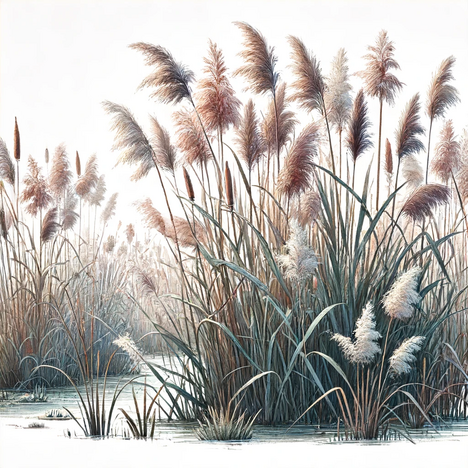Reed

Reed is a plant that grows on the banks of bodies of water and offers many benefits for dogs. In this article, you will find out what reed is, what it looks like, what positive and negative properties it has and how you can use it for your dog.
What is reed?
Reed is a perennial plant from the sweet grass family. It forms long, narrow leaves and round, brown inflorescences. Reed can grow up to four meters high and forms dense stands on the banks of lakes, rivers or ponds. Reed is widespread in Europe, Asia and Africa and is also known as reed or thatch.
What does reed look like?
Reeds have a strong, hollow stem, which is usually green or yellowish in color. The leaves are flat, narrow and sharp-edged. They can grow up to one meter long. The inflorescences are round, brown spikes that sit at the top of the stem. They contain many small seeds that are dispersed by the wind. Reed usually blooms in late summer or fall.
What are the benefits of reeds for dogs?
Reed offers many benefits to dogs, both as food and as shelter or toys. Here are some examples:
- Reed is high in fiber and can aid digestion in dogs. It can also help prevent or loosen hairballs.
- Reeds are a natural privacy and windbreak for dogs that like to be outdoors. It protects them from prying eyes or cold weather.
- Reed provides dogs with an exciting environment to explore, sniff or hide in. It stimulates their senses and hunting instincts.
- Reed can serve as a toy for dogs that like to chew or tug. It is soft enough not to damage teeth, but firm enough to offer resistance.
- Reeds can be used as nesting material for dogs that like to build dens or snuggle up. It is warm, cozy and insulating.
What are the disadvantages of reeds for dogs?
Reed also has some disadvantages for dogs that you should be aware of. Here are some examples:
- Reed can be contaminated with pollutants if it grows next to polluted water. It can then be poisonous or unhealthy for dogs.
- Reeds can have sharp edges that can injure dogs' skin or eyes. It can also contain splinters or thorns that can get stuck in the paw or mouth.
- Reed can cause allergies or intolerances in dogs that are sensitive to grasses. This can lead to itching, rashes or diarrhea.
- Reed can take up too much space or be undesirable when growing in the garden. It can crowd out other plants or disrupt the landscape.
How can you use reeds for dogs?
If you want to use reeds for dogs, you should follow a few tips:
- You should only use clean and fresh reeds that have not been treated with chemicals or pesticides.
- Only feed small amounts of reeds to avoid overdosing or constipation.
- Wash and dry the reeds well before feeding or playing to remove dirt or germs.
- Check and replace the reeds regularly to avoid mold or parasites.
- Always supervise your dog when handling reeds to avoid injury or poisoning.
Reed is a useful and decorative plant for dogs that offers many benefits. It can be used as food, shelter, toys or nesting material. However, it should also be used with care and responsibility to avoid harm. Reed can enrich the lives of dogs if used correctly.
If you notice any signs of hypersensitivity or poisoning in your dog, you should see your vet immediately. We are not a substitute for a vet, but we try to be as accurate as possible. Every dog reacts differently and we recommend you get a second opinion or consult your vet if in doubt.
Stay healthy and take good care of your four-legged friend!😊